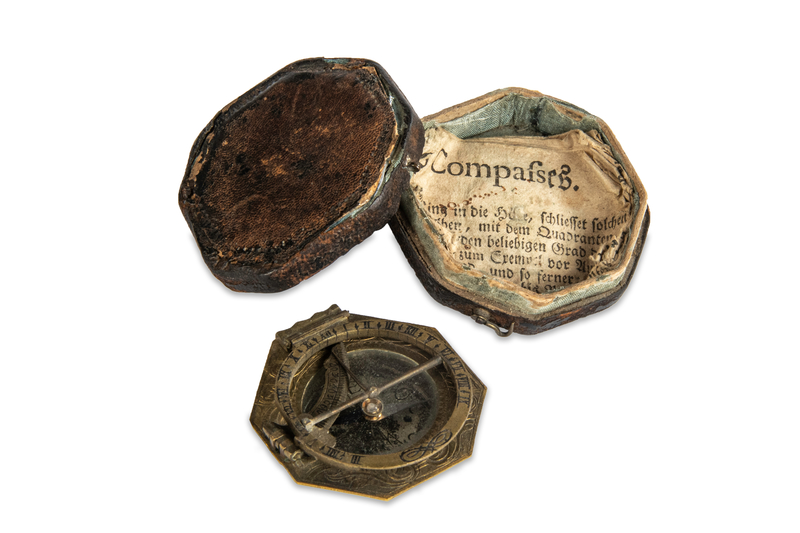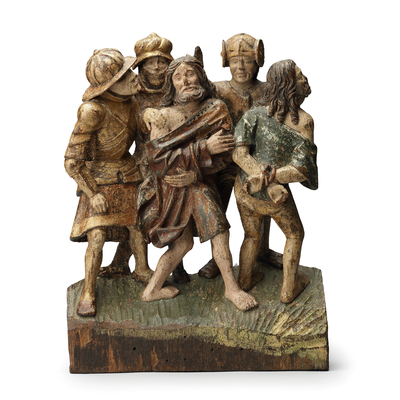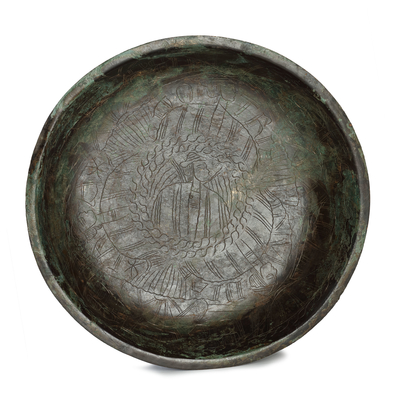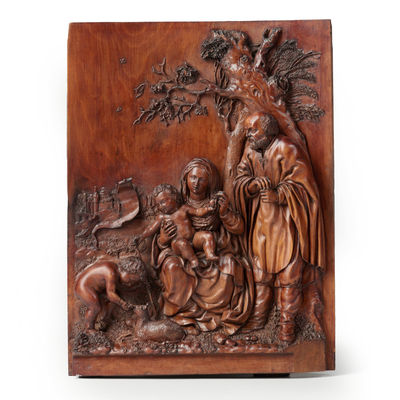Augsburg pocket sundial, Theodor Müller
Global shipping available
- Origin
- Augsburg
- Period
- C. 1710-1779
- Material
- Brass, glass, leather, silk, paper
- Diameter
- 6.5 cm
- Literature
B. Chandler & C. Vincent, ‘A Sure Reckoning: Sundials of the 17th and 18th Centuries’, The Metropolitan Museum of Art Bulletin, 1967, 26:4, pp. 154-169.
I. Fabian, ‘Tragbare Sonnenuhren in Europa ab 1400’, Plus Lucis 2007, p. 46.
Questions about this object?
Please use one of the contact options below:
Description
This remarkable brass pocket sundial with a compass and original leather case was made in Augsburg by Ludwig Theodor Müller (1710-1779). The equinoctial sundial consists of three parts: an engraved octagonal base, a hinged hour ring with gnomon, and a hinged arc divided into longitudes. The octagonal base has a glass-covered space for the compass. When the compass needle is pointed north and the hour ring is set at the correct angle with the protractor, the time can be read from the gnomon's shadow on the hour ring. The hours and half hours are indicated on the hour ring by Roman numerals, with a division from III to XII (morning) and I to IX (evening), with noon at the bottom of the ring. The octagonal base is decorated with geometric engravings of elegant curling leaves, diamond and triangular patterns. A compass rose is engraved on the bottom of the compass. The directions are indicated by the letters O | C, S | E, O | R, M | E: Occidentalis, Septentriones, Orientalis, Meridianus.
In order to be able to read the time at any place, the hour ring and gnomon must be adjusted to the correct angle. This requires the longitude of the place. On the back of the sundial is, therefore, a list of twelve cities followed by the longitude, engraved (Lisbon, Rome, Venice, Vienna, Munich, Augsburg, Nuremberg, Regensburg, Prague, Riga, Moscow, Saint Petersburg, Stockholm). Above the list is engraved ‘Elev Poli’, an abbreviation for ‘Elevatio Poli’: the longitude. In addition to these cities, the enclosed original printed German manual provides a more extensive list of cities, from Amsterdam to Adrianopolis, with the corresponding latitude. This allowed the owner to use the pocket sundial throughout Europe and beyond, as long as the sun was shining. Most of the cities mentioned are German. The manual, titled ‘Gebrauch dieses Compasses’, explains to the user how to use and set the sundial. The text is very legible, except for two damages on the folding lines. The manual concludes with ‘Ludovicus Theodatus Müller, Compass-Macher und Mechanicus in Augsburg’. The initials of Müller are engraved on the back of the sundial, below the list of cities: L.T.M. The equinoctial sundial was invented and produced in Augsburg in the 18th century.
The sundial is accompanied by a matching original octagonal leather case, lined with blue silk. The printed manual with the longitude is loosely folded in this case, under the sundial. The case closes with a little hook.








